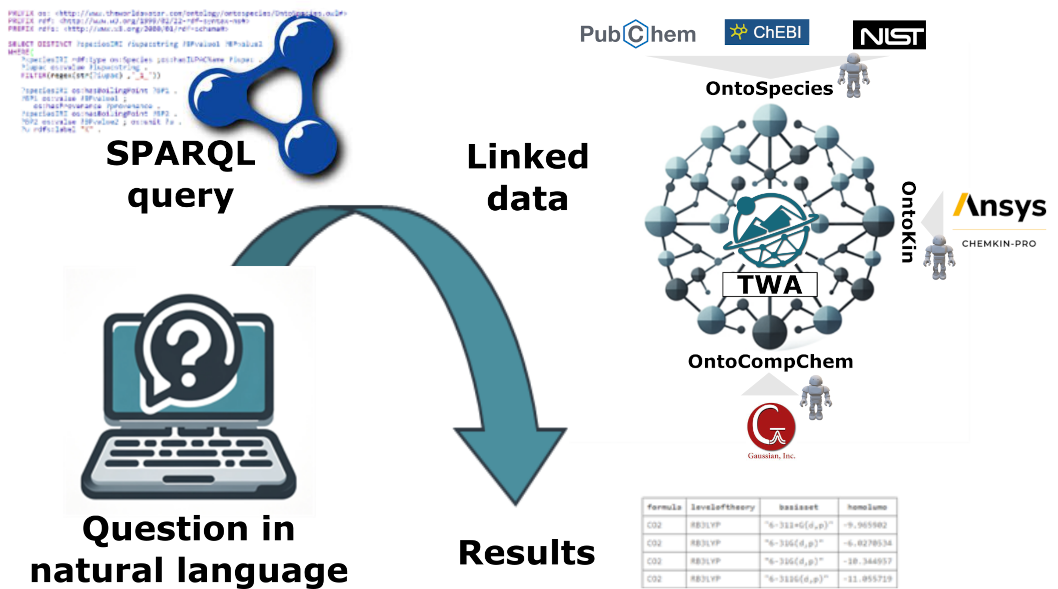Technical Report 315, c4e-Preprint Series, Cambridge
Question-answering system for combustion kinetics
Reference: Technical Report 315, c4e-Preprint Series, Cambridge, 2023
- A natural language question-answering system has been specifically developed for combustion kinetics.
- The system builds upon a dynamic knowledge graph based on semantic web technologies offering a unified approach to handling complex chemical data.
- Our approach combines a user-friendly access with rigorous data management that makes combustion kinetics data more accessible and machine actionable.
 In this paper, we introduce for the first time a natural language question-answering (QA) system specifically designed for the field of combustion kinetics. This system marks a significant step towards achieving the PrIMe vision as outlined by Frenklach in 2007, offering a user-friendly interface that allows researchers and practitioners to easily access and query information about chemical mechanisms. This QA system is a key component of "The World Avatar" (TWA), a dynamic framework built upon semantic web technologies. TWA is characterized by its layered structure, which includes a knowledge graph, software agents, and real-world data integration. These layers collectively create a comprehensive unified system for managing and analyzing complex chemical data from various domains. We detail the enhancements made to TWA's ontologies (OntoSpecies, OntoKin, and OntoCompChem) to meet specific challenges in chemical kinetics and improve their representation accuracy. By focusing on data provenance and interoperability, our approach ensures transparent and reliable data management that adheres to the FAIR principles, which is vital for precise information retrieval and analysis. The role of software agents in populating these ontologies is highlighted, showcasing how they transform raw data into meaningful structured knowledge and generate new insights within the TWA ecosystem. Additionally, the semantic web technologies' interoperability feature facilitates data integration and exchange across different platforms and tools, making the data machine-actionable. We then demonstrate the QA system's capabilities in answering questions related to four H2/O2 reaction mechanisms taken from the literature as a proof of concept. Lastly, we discuss the future directions of the TWA framework, which include not only future extensions of the QA system but also the integration of external tool to automate tasks such as generation of kinetic mechanism, further expanding TWA's functionality and application in the field of chemical kinetics.
In this paper, we introduce for the first time a natural language question-answering (QA) system specifically designed for the field of combustion kinetics. This system marks a significant step towards achieving the PrIMe vision as outlined by Frenklach in 2007, offering a user-friendly interface that allows researchers and practitioners to easily access and query information about chemical mechanisms. This QA system is a key component of "The World Avatar" (TWA), a dynamic framework built upon semantic web technologies. TWA is characterized by its layered structure, which includes a knowledge graph, software agents, and real-world data integration. These layers collectively create a comprehensive unified system for managing and analyzing complex chemical data from various domains. We detail the enhancements made to TWA's ontologies (OntoSpecies, OntoKin, and OntoCompChem) to meet specific challenges in chemical kinetics and improve their representation accuracy. By focusing on data provenance and interoperability, our approach ensures transparent and reliable data management that adheres to the FAIR principles, which is vital for precise information retrieval and analysis. The role of software agents in populating these ontologies is highlighted, showcasing how they transform raw data into meaningful structured knowledge and generate new insights within the TWA ecosystem. Additionally, the semantic web technologies' interoperability feature facilitates data integration and exchange across different platforms and tools, making the data machine-actionable. We then demonstrate the QA system's capabilities in answering questions related to four H2/O2 reaction mechanisms taken from the literature as a proof of concept. Lastly, we discuss the future directions of the TWA framework, which include not only future extensions of the QA system but also the integration of external tool to automate tasks such as generation of kinetic mechanism, further expanding TWA's functionality and application in the field of chemical kinetics.
Material from this preprint has been published in Proceedings of the Combustion Institute.
PDF (5.6 MB)



